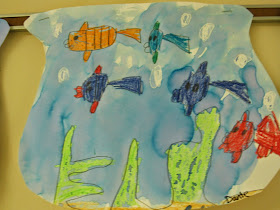
Wednesday, June 4, 2014
Hundertwasser Trees
Third grade students first compared the artwork of Gustav Klimt and Natasha Wescoat. Then they compared those two artists to yet another artist; Freidensreich Hundertwasser. They discussed the many places spirals can be found in nature after reading " Swirl by Swirl" by Joyce Sidman and discovered that Hundertwasser loved spirals because they are so natural. They created these spiral trees inspired by the spiral trees that Hundertwasser painted.


Molas
Molas are made by the
Kuna people who live in Panama
and Colombia
Fourth Grade students
designed their own molas, but created them in the opposite way of the Kuna
women. Usually, the artist must cut away layers of fabric to show the fabric
underneath. Instead of doing this, students glued layers of paper together,
showing just a little bit of the color underneath.
Laurel Burch Cats
Second Grade students looked at the artwork of Laurel Burch and heard a little background about her life. They learned she had a hard life, but created fun, whimsical cats because they made her happy. After looking at various examples of her artwork, they created cats that featured a lot of bright colors, pattern and repetition.


Bubble Wrap Printing
First grade students printed bubble wrap to create snakes and underwater scenes. Students discussed the difference between printing and painting and came to the conclusion that printing is much like using a stamp. Sometimes the artist uses pre-made materials like cups or bubble wrap to use as a stamp, and sometimes the artists creates their own "stamp" when they carve a printing block.
Fish Resist
Kindergarten students
used crayons and watercolor paint to create a fish resist. Students learned
that crayons have oil in them that resists the watercolor paint so they could
paint right over their fish drawing. Students created their own unique fishbowl
after looking at different types of fish.
Mehndi Hands
Second
Grade students learned that art takes many forms around the world. They
discovered that people in many Middle Eastern countries decorate their hands
with Mendhi for special occasions such as weddings. Mendhi is a paste that is spread
on to the hands and is carefully scratched off with a small wooden tool to
create intricate patterns. They learned that many designs incorporate a paisley
pattern. Students then created their own Mendhi hand designs.
Secondary Colored Flowers
Kindergarten students read "Mouse Paint" by Ellen Stoll Walsh. Then students experimented with mixing the primary colors to get secondary colors. They each painted a paper with the colors they made. The next week, students reviewed how to create secondary colors. Then they studied still lifes. They each created their own still life of flowers in a vase by cutting up their secondary colored paper and gluing it to another paper.


Swirly Trees
Third grade students compared the work of Gustav Klimt and Natasha Wescoat. Students discovered that Wescoat was inspired by Klimt's swirly trees. Though her artwork is similar, it is not a copy, no one would ever mistake the two artists. Students discussed the difference between copying an artist and being inspired by them. Then students created these swirly tree sculptures after being inspired by the two artists!
























